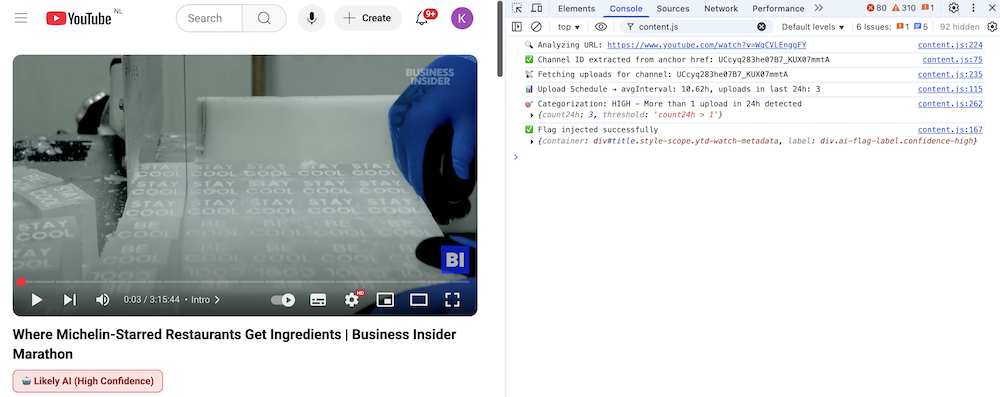A Chrome Extension That Flags AI (Sort Of)
Why
One quiet weekend, I got bored and decided to build something fun. While browsing YouTube, I noticed I kept ending up in a rabbit hole of AI-narrated videos—content that felt strangely synthetic, usually from faceless content farms. It made me wonder: Could I build something that flags these types of videos?
At first, I had ambitious ideas—analyzing audio for synthetic narration, checking for human presence in thumbnails or videos—but quickly realized that was out of scope for a hobby project. Instead, I settled on a simple, imperfect proxy: the upload rhythm of a channel.
It’s not particularly accurate, but it was something I could build, and to my surprise, it actually worked just well enough to feel satisfying.

The Chrome Extension in Action
What
I built a Chrome extension that flags potentially AI-generated YouTube content by analyzing how rhythmically and frequently a channel uploads. Think of it as a small prototype trying to detect when something’s just… a bit too efficient.
What it does:
- Detects the Channel ID from the currently viewed YouTube video.
- Uses the YouTube Data API to fetch the last 10 uploads.
- Analyzes the average interval between uploads and flags if multiple uploads occur in a 24-hour window.
- Applies a very rough, arbitrary classification of AI-likelihood.
- Injects a message on the video page (and logs data to the console).
It’s not rigorous or scientific—but for a one-person side project, it delivers on what I needed: a nudge, not a verdict.
Limitations
- The YouTube Data API has strict quotas—about 100 requests/day with the default key.
- Navigation quirks: if you go from a channel page to a video, you’ll need to refresh.
- It doesn’t actually detect AI—just upload frequency—but it happens to correlate surprisingly well with the kind of content I personally find suspicious or low-effort.
How
I built the extension using Visual Studio Code, Cline, and a rotating cast of LLMs—ChatGPT, Claude Sonnet, and others.
At first, I worked manually, editing files one by one to understand how Chrome extensions are structured (manifests, content scripts, background scripts, etc.). It was a bit clunky, but helped me get the basics down.
Eventually, I started using Cline to refactor and generate code across files, which sped things up considerably. It felt like pair programming with an assistant who never gets tired.
I didn’t track API usage precisely, but I estimate the whole thing cost me around $4 in tokens. Not the most efficient, but totally worth it for the experience.
Conclusion
What started as a tool to flag AI-generated content turned into a fun way to explore AI-assisted coding. I’ve heard people call this kind of process vibe coding—building something based on intuition, curiosity, and just seeing where it takes you.
I think I’ll be doing this a lot more.
GitHub Repo
https://github.com/koostenbras/ai-content-flagger